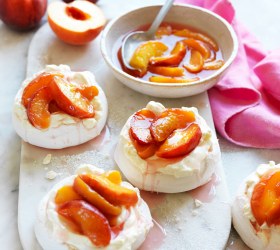Easy tips for making perfect meringue
Meringues in the form of pavlovas, toasty peaks on lemon meringue pie, or even plain meringue kisses are a classic family treat. However, they can be a little finicky. When meringues go wrong after following a recipe to a T, we end up scratching our heads wondering what in the world happened. Well, we have easy tips and answers to frequently asked questions to ensure you always get the perfect meringue!
What equipment do you need to make meringue?
- An electric stand mixer or hand-held electric beater will make whipping your meringue easy. You could also use a balloon whisk (and lots of elbow grease).
- Traditionally, for the very best volume, copper pans were used. Today, a clean glass or stainless bowl is all you need. Avoid plastic bowls as they more easily retain traces of fat.
- Any fat or oil residue will stop the egg white from getting fluffy, so all your equipment must be scrupulously clean and dry.
- For separating the eggs, you will need an egg separator and a couple of small bowls.
How to separate eggs
Separating eggs for meringues can be tricky, as it is essential that there is no trace of egg yolk in the egg white. Since the egg yolk is fatty, even a tiny amount of yolk will reduce the whisked volume of your meringue by up to two-thirds.
Follow these tips to get perfectly separated eggs:
- Use cold eggs – cold eggs crack easier than room temperature eggs, so crack and separate your eggs straight out of the fridge.
- Crack eggs on a flat surface – not the lip of a bowl. This reduces the chance of getting shell in your egg or breaking the yolk.
- Use an egg separating tool -– there are tools available that sit over a small bowl and catch the yolk, letting the white fall into the bowl perfectly every time. Or you can use your hands, letting the whites fall through your fingers as you catch the yolk.
- Collect successfully separated whites in another bowl – As you separate each egg, tip the egg white into the large bowl that will be used for whisking. By doing this, if you get some egg yolk into the white it will only affect one egg, not all of them. As for the egg yolks, find out how to use them here.
Top tip: Room temperature egg whites will whip up much faster than cold egg whites. Stand egg whites at room temperature for maximum 30 minutes to remove refrigerator chill.
Why do you have to add sugar to meringue slowly?
The sugar is added gradually so that it completely dissolves. If the sugar isn't completely dissolved, your meringue may 'weep' or crack. Spoon one to two tablespoons of sugar at a time into the egg whites, whisking for 30 seconds between each addition. The mixture will double in size and begin to thicken. The colour will turn white, and the meringue will appear glossy.
How can you tell when the sugar has dissolved into the meringue?
To check that the sugar has dissolved into the egg whites, spoon a little of the meringue between your thumb and forefinger and rub together. If the sugar is not dissolved the mixture will feel grainy. If this happens, continue to whisk until the mixture no longer feels grainy.
Do you need cream of tartar to make meringue?
Yes and no, cream of tartar is an acid used to stabilise the foamy meringue, making it less likely to overwhip and collapse. If you don’t have it in your pantry, you can substitute it with a one teaspoon of white vinegar or 2 teaspoons of lemon juice.
How does meringue get fluffy?
As egg whites are beaten, the protein (called albumen) form tiny filaments which expand while incorporating air. Fun fact: a perfectly whisked meringue can be 8 times its original volume!
What do soft peaks look like in meringue?
Check if you have soft peaks by picking up your beaters or whisk, and look at the foam in the bowl. The foam should form a peak and fall over to one side immediately (like the tip of a soft serve cone). At this point you can begin adding sugar gradually.
What do firm peaks look like in meringue?
Following the steps above, firm peaks or stiff peaks should point straight up. They will not fall to the side.
At what speed should you beat meringue?
Start whisking egg whites on low speed until they turn foamy with small bubbles forming. Add your acid of choice and increase beaters to medium speed, until the egg whites reach soft peaks. Begin gradually adding sugar at this point. Once all the sugar has been added, increase the speed to medium high and beat until meringue forms firm or stiff peaks.
Overbeaten meringues will separate and begin to break up into clumps. This is irreversible. If you haven’t made meringue before, you can reduce the speed at the final stage and check more often to see if you have reached stiff peaks to avoid overbeating your meringue.
What temperature should I cook my meringues at?
- Soft Meringues – 180°C – approx. 15-20 minutes – this crisps the surface but leaves the centre moist and chewy.
- Hard Meringues – 110°C-150°C – 1-2 hours – this dries out the meringue and it is usually left in the oven to cool completely. Higher temperature will lightly colour the meringue.
Why is my meringue weeping, collapsing or cracking?
- Baking temperature is too high – this will cause the proteins to cook too quickly, squeezing out the moisture and forming beads on the surface.
- Baking temperature is too low – the excess moisture in the meringue will cause it to leak syrup and collapse.
- Sugar was not dissolved completely – the undissolved sugar will cause the meringue to leak syrup. Ensure sugar is added slowly. Make sure you can't feel any grittiness when you rub the meringue between your fingers before baking. Keep whisking if it feels gritty.
- Cooled too quickly – this can cause collapsing and cracking, especially with pavlovas. Allow the meringue to cool slowly in the oven for at least an hour, and up to overnight.
- High humidity – A humid or rainy day is the enemy of meringue. The sugar absorbs the moisture in the air and produce droplets on the surface. Store meringues in airtight containers in a cool, dry place.
Can I cook other things in the oven with my meringue?
Avoid cooking anything else in the oven with your meringue, as it will affect the humidity and temperature in the oven.
Hopefully you now have all the information to make the perfect meringue, every time! Use these tips to make one of the meringue recipes below, and find out what to do with those extra egg yolks.
Meringue recipes
Check out lots of Meringue Dessert Recipes or take a look at the recipes below.
GET THE RECIPE: Rosewater and Raspberry Meringues by Australian Eggs
Delicious with a dollop of fresh cream, these cute and easy meringues make a great treat.
GET THE RECIPE: Meringue-Amisu by Australian Eggs
This epic dessert has all the flavours of tiramisu! Hazelnut meringue, whipped coffee-chocolate ganache and mascarpone cream make this one unforgettable treat.
GET THE RECIPE: Passionfruit Curd and Coconut Meringue Jars by Australian Eggs
These dessert jars look stunning and are irresistibly tasty.
Make this show-stopping Aussie favourite, using the egg yolks for a zingy lemon curd. Yum!



























